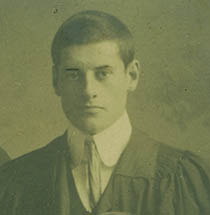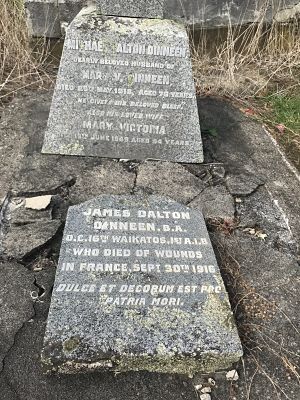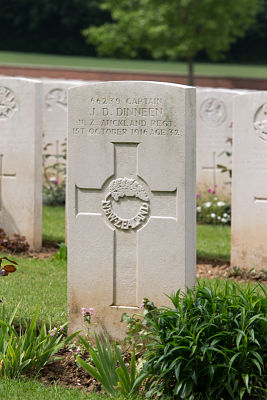WW1 Flight-Lieutenant & Captain James Dalton Dinneen 66239
James (Jimmy) Dinneen was born 16 July 1883, the fourth of six children of Michael Dalton and Mary Victoria Dinneen (nee Given) of Unchinagh, Mountain Rd (16 Upland Rd), Remuera.
His father Michael Dinneen fought in Taranaki and the Waikato during the New Zealand wars in the 1860s. The family lived at Kihikihi and farmed at Ohaupo from the late 1880s, before moving to Remuera. [1]
He won a scholarship to the Auckland Grammar School, and then a senior scholarship under which he trained at the school, from 1897 to 1901. Next, he won a New Zealand University scholarship. While a scholar at the Grammar School James was captain of its first football fifteen, played in senior Rugby football, and when at college was captain of the St. John football team when it won the six-aside championship. When Lord Kitchener was in Auckland and presented colours to the Grammar School cadets, Captain Dinneen was one of the officers who handed the colours to him for the purposes of the ceremony. He was also captain of the Grammar School cadets prior to his enlistment. [2]
Attending both Auckland University College (AUC) and the affiliated St John’s College from 1902-1904, Dinneen scored first class passes in most university subjects and won premiums for Latin and English for his B.A. degree. A member of the AUC Students’ Association Executive in 1903, Dinneen also captained football for the St John’s-turned University football team. He graduated BA in 1905 and was AUC’s nominee that year for a Rhodes Scholarship. His elder sister Alice studied at AUC, graduating BA in 1901, while younger brother Richard also briefly attended. [3] In 1907 James gained a position as teacher at Auckland Grammar School where he was also Officer in Charge as Captain of the No. 2 Senior Cadets military unit.
After war broke out in 1914, James sought one year’s leave from the school in order to proceed to England to study for the pilot certificate in aviation and qualify himself for service in the military wing of the Royal Flying Corps. The Headmaster, Mr J. W. Tibbs, supported his application for leave of absence for this purpose. He stated that the applicant had been eight years on the school staff, and had always taken an active part in the Cadet movement. The majority of the governors present expressed the view that any man desiring to fight for his country should be encouraged, though Mr J. H. Upton raised the point that a schoolmaster’s place was hard to fill. It was agreed to grant Mr Dinneen one year’s leave of absence on half-pay. [4] Prior to his departure from Auckland James Dinneen was presented with a wristlet watch by the staff of the Grammar School, the presentation being made by the headmaster, Mr. J. W. Tibbs. He left Wellington on 1 February 1915 by the steamer Remuera for England, accompanied by his sister Charlotte. [5]
James and Charlotte arrived in England on 23 March 1915 and James received a commission as a lieutenant and his probationary flying certificate, after three weeks at the Military School, Brooklands, training on a Maurice Farman biplane on 30 April 1915. [6] This was dependent on three months further flying training before being considered for active service. [7] However, James had to relinquish his commission owing to a defect in eyesight which meant he couldn’t properly calculate his plane’s landings. This must have been very disappointing for him, but he was deemed to be an excellent officer, so was able to attend the Inns of Court Officer Training School from September to November 1915 in London. He then said he could have obtained an Infantry commission in Kitchener’s Army but wished to serve in the New Zealand forces. Rather than wait for a draft returning to New Zealand, he proceeded at his own expense on the S S Malwa to Egypt to join the N Z Expeditionary Force, as he was, he said, anxious to get to work as soon as possible.
He arrived in February 1916 and one month later was promoted to Captain on 1 March 1916 with the 16th (Waikato) Company, 1st Auckland Battalion, Auckland Regiment. [8] In Egypt, training continued without respite all through March. On April 3rd Sir Archibald Murray inspected the troops. The New Zealand Division, under Major-General Sir A. H. Russell, K.C.M.G., was to proceed to France. On the night of April 5/6th, 1/Auckland entrained for Port Said, and there embarked on the Franconia. [9] 1/Auckland arrived on April 16th 1916. The New Zealanders joined the fighting on the Western Front in mid-1916 in the French Armentières sector, where Dinneen earned praise for his efforts in the trenches.
For the next three months trench warfare went on without interruption, and gradually increased in intensity.
July 1, 1916, the storm burst on the Somme. [10] On the 27th September, eight hundred men of 1/Auckland went over against the Gird System. They came up against uncut barbed wire and were mown down by machine-gun fire as they attempted to find gaps. When the line was taken two hundred were left. Three times 1/Auckland had charged as a battalion—once at Helles, once at Chunuk, and again over the shell-torn field of the Somme—and on every occasion they had been slaughtered by a cruel concentration of machine-gun fire. The 16th Waikato Company had been especially unfortunate in this last charge, Lieutenant Hogg and six men being all that remained. Many brave men had fallen. Captain Dineen went over, leading the first wave of the 15th Company, to fall mortally wounded half-way across.
Ormond Burton wrote: “the Regiment never lost a finer officer. The trench warfare at Armentières had shown him to be the very finest type of soldier, a man endowed with a splendid physical self, of great mental ability, with a will like steel and a nerve that nothing could shake; absolutely conscientious, strict, but just and very thoughtful, a man who “reverenced his conscience as his king.” He was the bravest man in his company because he was the best. Terribly wounded as he was, he continued to direct his men as the successive waves passed him. The stretcher-bearers, Porter, Forrest and other gallant men made great efforts to save him, but after three of them had fallen in the attempt they were compelled to wait. He died on the way to the Base.” [11] Dinneen was not admitted to No.63 Field Ambulance in the field until the 29th of September. He had multiple gunshot wounds, arriving at 36 Casualty Clearing Station on 1 October 1916, where he died.
He was Mentioned by Sir Douglas Haig in his Despatch of the 1st November 1916. The citation read “For gallantry and devotion to duty. He led his company brilliantly in the attack on Gird Trench on September 27th 1916. He was first hit by a machine gun bullet but kept on till hit by a shell. Unfortunately, he has since succumbed to his wound. D.O.W. France 1 October 1916.” [12] Norman Duthie, brother of Keith Duthie, was also mentioned in the same despatch.
Lieutenant-Colonel Plugge, commander of the First Auckland, Infantry Battalion, of the New Zealand Expeditionary Force, wrote-” Captain Dinneen was wounded on September 27. He was gallantly leading his company to the attack on Gird Trench, and, although he was twice wounded in the arm by machine-gun fire, he went on but a shell burst close to him, fracturing his thigh, and a fragment striking him in the chest. We were not able to get him in until September, 28. Three men were hit in attempting it but one of his men got out to the shell-hole with food and drink and covered him up. I saw him when they got him in, and immediately arranged for a change of stretcher-bearers. He was quite cheerful, and only wanted something to drink. My doctor told me afterwards that he had hopes that his fine constitution would pull him through, but it turned out that he had been hit by a phosphorus shell.
In expressing his sympathy with the family in their bereavement, Colonel Plugge adds; He was a splendid company officer, beloved by his men, arid absolutely devoid of all fear. I miss him not only as an officer but as an old personal friend, and, though I was responsible for his joining the New Zealand Expeditionary Force, I do not regret it, and I don’t think that he would.”
Private F. Watson, of the 16th, Waikato Company, says: “On September 27 we made an attack. It took place in. four waves. Captain Dinneen should have gone over with the third wave, but, being such a keen and brave man, he went with the first wave. We topped the parapet at 2.15 p.m., Captain Dinneen in the lead, a pistol in either hand. I was near/him right up to the time he fell about half-way between our trenches and the Hun barbed wire, a shell burst alongside him. The last I saw of him he was sitting in a shell hole, and he did not appear to be in any agony. I was wounded myself the same night, but one of our boys told me they got Captain Dinneen to a dressing-station, where he died on October 1. He was absolutely the bravest and coolest man I have ever met. He was strict and conscientious, but we all loved him as a gallant officer and a man. I have never come across an officer who did so much for his men. He was with us heart and soul, and we with him. It was a common saying among us on the war to the Somme that if Jimmy Dinneen came through, he would get the D.S.0. or a decoration of some sort. He was too good and brave a man to last—it is always the best that go under.” [13]
Ormond Burton’s history of the Auckland Regiment said: “Enlisting at the outbreak of war, he had trained for the Royal Flying Corps. After rejection by the R.F.C. he at once joined the NZEF offering to resign his Commission and serve in the ranks as a private. He was not allowed to do this and was attached to 1/Auckland as a Captain. The trench warfare at Armentieres had shown him to be the very finest type of soldier, a man endowed with a splendid physical self, of great mental ability, with a will like steel and a nerve that nothing could shake; absolutely conscientious, strict but just and very thoughtful, a man who ‘reverenced his conscience as his King’. He was the bravest man in his Company because he was the best. Terribly wounded as he was, he continued to direct his men as successive waves passed him. The stretcher-bearers, Porter, Forrest and other gallant men made great efforts to save him but after three of them had fallen in the attempt they were compelled to wait. He died on the way to the Base on 1.10.1916″. [14]
Mr. J. W. Tibbs, Headmaster of Auckland Grammar School, at the 1916 prize-giving, made reference to the death of Captain James Dalton Dinneen from wounds received in the battle of the Somme. The report stated that the late captain was a distinguished scholar of the school, an able master, a helpful colleague and a fearless soldier. The school roll of honour had grown from 33 killed and nine missing in December 1915 to a 90 killed and 14 missing; whilst out of a total of 920 with the colours, the names of 123 appeared as wounded and two as prisoners of war. Practically there were no old boys in residence at British universities, and in place of the usual list of academic distinctions, there was one of the military honours, including one Victoria Cross, one C.M.G., nine Military Crosses, three D.C.M.’s, four Military Medals, and seven old boys had been mentioned in despatches. [15]
James Dinneen is buried at Heilly Station Cemetery, Mericourt-l’Abbe, Somme, France (Grave reference III.A.24.) and is commemorated on the memorial cross at St Aidan’s Church, Remuera.



